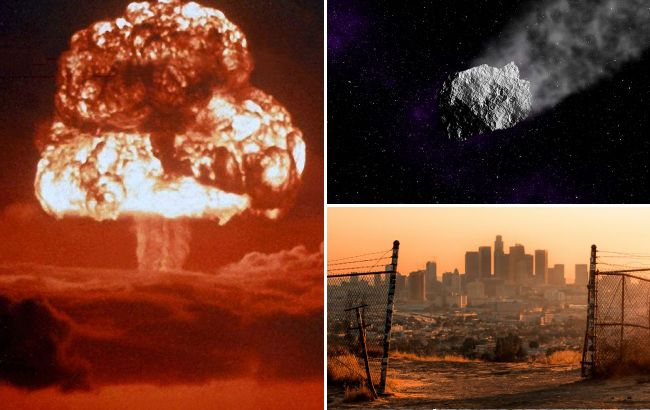When all life on Earth disappears: Scientists identify possible causes
 Life on Eath is not eternal (Collage RBC-Ukraine)
Life on Eath is not eternal (Collage RBC-Ukraine)
Nothing on Earth is eternal. Most people realize that sooner or later, humanity, like the rest of the living organisms on our planet, may disappear. At the same time, various theories exist regarding the possible reasons for the extinction of all life.
During preparing this material, the following sources were used: Astronomy, BBC, NASA, Nature, Live Science.
Asteroid
According to some scientists, an asteroid could be capable of destroying all life on planet Earth.
According to NASA data, our planet is struck by a large asteroid approximately every 100 million years, while collisions with smaller asteroids happen constantly.
Simulations conducted by researchers suggest that only a truly gigantic asteroid could wipe out life on Earth.
Moreover, the impact site of such a celestial body, the angle of collision, and the type of rock it hits on our planet's surface all matter.

Asteroids come in different varieties (Photo: Pixabay)
Wandering star
Some scientists are concerned about so-called rogue stars that may approach at a dangerous distance and, theoretically, have a negative impact on Earth.
A group of researchers led by Eric Mamajek from the University of Rochester in New York identified, back in 2015, that about 70,000 years ago, a red dwarf star called Scholz passed through the outskirts of the Solar System, through a region known as the Oort Cloud.
Experts note that this incident with the rogue star was not the first and certainly won't be the last. If another star comes too close to the Solar System and our planet, it could pose a threat to life on Earth.

Wandering stars (illustrative photo: Pixabay)
Gamma rays
Another danger to our planet is gamma rays, which refer to electromagnetic radiation of the highest energy.
These rays can be emitted during powerful cosmic events, such as the explosion of a giant star or the collision of two stars, lasting from a fraction of a second to several minutes.
Since gamma-ray bursts most frequently occur near the center of a galaxy or in regions with a high density of stars, Earth is relatively safe. However, scientists have identified instances of accidental gamma-ray exposure (traces found in fossils).
In theory, prolonged exposure to gamma rays could destroy Earth's ozone layer, leaving all living organisms unprotected against deadly solar ultraviolet radiation.

Gamma rays can destroy the ozone layer (Illustrative Photo: Pixabay)
Supervolcano
Another theory regarding the destruction of life on Earth is associated with volcanic activity of apocalyptic proportions.
According to Henrik Svensen from the University of Oslo in Norway, the scale of species destruction will directly depend on the location where lava breaks through the Earth's crust.
Rocks heated by volcanic activity can eject a vast amount of chemicals into the atmosphere, which will destroy the ozone layer.
As a result, the Earth will receive a powerful dose of solar radiation, and all life on it will vanish.

Supervolcano can completely change the Earth (illustrative photo: Pixabay)
Core
Some researchers believe that the Earth's magnetic field deflects ionizing radiation from the Sun, which would otherwise destroy the atmosphere.
Since the magnetic field depends on the electromagneto-mechanical processes in the outer core of the Earth, any changes in the core could potentially affect the magnetic field.
Despite concerns from some scientists about the cooling of the Earth's core or the weakening of the magnetic field, most of their colleagues argue that nothing catastrophic is happening.
According to Richard Harrison from the University of Cambridge in the United Kingdom, for the complete disappearance of the Earth's magnetic field, the core must solidify completely. However, currently, only its inner part is solid, while the outer part remains liquid.

Magnetic Field of the Earth - an integral component (illustrative photo: Pixabay)
Oxygen
The Earth's atmosphere hasn't always been as it is now. The world we know formed, in part, due to oxygen produced by blue-green algae.
Some modern research points to a negative trend – climate change significantly reduces the oxygen levels in the global ocean. This could have adverse effects on marine species and humanity as a whole.
Deforestation and the destruction of other green areas that provide us with oxygen and maintain the atmospheric balance may lead to the extinction of all life on the planet.
This alarming process, known as deoxygenation, is a cause for concern among scientists.

Oxygen is the basis of life (photo: Pixabay)
The Sun
The most apparent reason for the demise of our planet, according to many scientists, is the transformation of the Sun.
According to planetary scientist Ravi Kopparapu from NASA's Goddard Space Flight Center, over time, the Sun will evolve into a large red giant through natural processes, eventually engulfing the Earth.
Initially, against a backdrop of constant heat and high humidity, humanity will perish. In such conditions, our bodies won't be able to cool down through sweating, leading to their demise (essentially boiling under extreme heat).
Later, when the Sun's brightness is nearly 20% more than it is now, the world's oceans will begin to evaporate.

Every star dies sooner or later (illustrative photo: Pixabay)
Self-destruction
The last and most probable theory, according to many scientists, is "self-destruction" due to the negative impact of human activity on the planet.
Peter Ward from the University of Washington in Seattle is convinced that the greatest threat to life on Earth comes from "within."
He calls his idea the "Medea hypothesis" - named after the Greek queen who killed her own children.
According to the scientist, no single cataclysm can completely destroy life. However, if the internal balance of the biosystem is disrupted, and another blow is dealt from space, life may disappear forever.
We previously discussed how many people would live on Earth in 2100 and whether the planet is ready for such changes.

